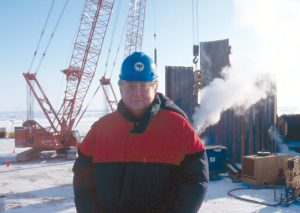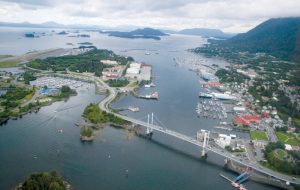Alaska’s Bridge Builder
Dennis Nottingham, P.E., was a bridge builder. “I designed a lot of bridges, the big ones. The Yukon. The Gulkana. I worked on every single bridge – construction bridges, access bridges – on the Trans-Alaska Pipeline in some form or another,” Nottingham said during his company’s 40th-anniversary celebration in 2019 in Anchorage. His Hall of Fame biography credits Nottingham with more than 300 bridge designs in Alaska.
Bridges brought Nottingham to Alaska, and bridges are what Nottingham will be immortalized for in Alaska. He was enshrined in 2015 as “The Bridge Builder” into the Northern Innovators Hall of Fame by the Alaska Statewide Committee for Research.
William Dennis Nottingham died on March 6, 2022. He was 84 years old. Nottingham will be remembered as one of Alaska’s most influential engineers.
After graduating from Montana State College with his master’s degree in civil/structural engineering, Nottingham worked for the State of Montana, designing bridges for the country’s fledgling Interstate Highway System under the Eisenhower Administration. He answered a local classified advertisement calling for bridge engineers to expand Alaska’s nascent road system, then moved to Juneau in 1962 for a job at the Alaska Department of Highways in its bridge design section. There he met Roy Peratrovich, Jr., the bridge design section squad leader.
“When I came up here, I had no concept of the opportunities that were ahead,” Nottingham said. “I came because I liked the outdoors.”
The situation suited him well. Nottingham and Peratrovich worked together at the state for 10 years and another seven in the private sector, designing iconic bridges such as the Gulkana River Bridge, Sitka Harbor Bridge, and Yukon River Bridge. The pair eventually partnered in their own consulting engineering firm startup in 1979, Peratrovich & Nottingham, Inc. Now known as PND Engineers, Inc., the firm proudly carries on its founders’ legacy of innovative engineering services and features offices in Anchorage, Juneau, Seattle, Washington; Portland, Oregon; Houston, Texas; and Vancouver, B.C.
The Sitka Harbor Bridge is arguably their most famous bridge because of its place in American history. In 1969, Peratrovich, the state’s design squad chief, and Nottingham, who performed design check and structural analysis for the project, designed the 1,255-foot-long bridge over the Sitka Channel, linking Sitka to Japonski Island. It is credited with being the first cable-stayed vehicular crossing in U.S. history.
The bridge was recognized by the American Society of Civil Engineers Alaska Section as a State Historic Civil Engineering Landmark on September 11, 2022.
“There was so much deflection analysis that had to be made because you had different deflection capabilities at different points where the cable was attached,” Peratrovich recalled of the unprecedented design. “It was pretty complicated, but Dennis figured out a way to do it.”
During the 1970s, Nottingham was the lead designer for the 400-foot-long tied-arch Gulkana River pipeline bridge along the Richardson Highway in Southcentral Alaska, which used steel piles driven into permafrost, setting a new arctic engineering standard. The bridge was designed, fabricated, and constructed in six months – 15 days ahead of schedule. Nottingham was also the lead designer for the 2,297-foot-long Yukon River Bridge along the Dalton Highway, approximately 135 miles northwest of Fairbanks. The largest bridge in Alaska at the time featured unprecedented aboveground twin oil and natural gas pipelines, a low-temperature steel box girder design, and is believed to be the first to include modern seismic design.
“Dennis was certainly a bridge designer. His first love was designing bridges, and they were beautiful bridges, too. Still, they were practical,” said consultant and former PND business partner William Gunderson, P.E., whose GUNDERBOOM™ technology also received international acclaim in the late 1980s and early 1990s under the umbrella of PND’s research and development department. “I think Dennis’ biggest development was the OPEN CELL technology. There’s no question.”
Nottingham won the prestigious NOVA Award from the Construction Innovation Forum in 1998 for PND’s proprietary OPEN CELL SHEET PILE™ (OCSP) bulkhead technology. PND, which holds multiple U.S. patents on the tech, has designed more than 200 OCSP systems valued at more than half a billion dollars since Nottingham pioneered the design in the early 1980s, with installations across the U.S. and internationally, including Bermuda, Canada, Guyana, Iraq, Philippines, and Russia.
In addition to his NOVA Award, Nottingham won 15 James F. Lincoln Arc Welding Foundation Awards for various projects during his 30-year career at PND, believed to be a U.S. record. He has held as many as nine U.S. patents. He won the Associated General Contractors of Alaska Hard Hat Award in 2004, an honor typically reserved for construction contractors.
Peratrovich left the following comment on Nottingham’s tribute wall on the Croxford Funeral Home website: “Dennis was my friend for nearly 60 years. Together we raised young families, hunted and fished, designed bridges and marinas, and founded a successful engineering firm. So many memories! RIP, sir.”■


